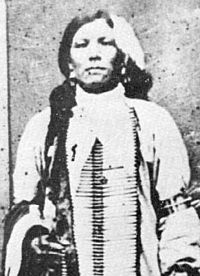Crazy Horse facts for kids
Quick facts for kids
Crazy Horse
|
|
|---|---|

Could be photograph of either Crazy Horse or his brother.
|
|
| Born | c. 1838 |
| Died | September 5, 1877 |
Crazy Horse, literally "His-Horse-Is-Crazy"; was a Native American war leader of the Oglala Lakota in the 19th century. He took up arms against the United States federal government to fight against the take-over by white American settlers on Indian territory and to preserve the traditional way of life of the Lakota people.
His participation in several famous battles of the American Indian Wars on the northern Great Plains, among them the Fetterman massacre in 1866, in which he acted as a decoy, and the Battle of the Little Bighorn in 1876, in which he led a war party to victory, earned him great respect from both his enemies and his own people.
In September 1877, four months after surrendering to U.S. troops under General George Crook, Crazy Horse was fatally wounded by a bayonet-wielding military guard, while allegedly resisting imprisonment at Camp Robinson in present-day Nebraska. He ranks among the most notable and iconic of Native American warriors and was honored by the U.S. Postal Service in 1982 with a 13¢ Great Americans series postage stamp.
Early life

Sources differ on the precise year of Crazy Horse's birth, but most agree he was born between 1840 and 1845. Crazy Horse was born to parents from two tribes of the Lakota division of the Sioux.
His father, born in 1810, was also named Crazy Horse. Crazy Horse was named Cha-O-Ha ("In the Wilderness" or "Among the Trees") at birth, meaning he was one with nature. His mother, Rattling Blanket Woman (born 1814), gave him the nickname "Curly" or "Light Hair", as his light curly hair resembled her own. She died when Crazy Horse was only four years old.
Crazy Horse was known to have a personality characterized by aloofness, shyness, modesty and lonesomeness. He was generous to the poor, the elderly, and children.
Through the late 1850s and early 1860s, Crazy Horse's reputation as a warrior grew, as did his fame among the Lakota. The Lakota told accounts of him in their oral histories.
Personal life
The love of his life was Tȟatȟáŋkasápawiŋ (Black Buffalo Woman), who was married to another man named Mní Níča (No Water). At one point, Crazy Horse persuaded Black Buffalo Woman to run away with him. No Water borrowed a pistol and ran after his wife. When he found Crazy Horse, he fired at him, injuring him in the face and leaving a noticeable scar. Crazy Horse was married twice, first to Tȟašinásápawiŋ (Black Shawl) and second to Nellie Larrabee (Laravie). Only Black Shawl bore him a child, a daughter named Kȟokípȟapiwiŋ (They Are Afraid of Her), who died at age three.
Crazy Horse Memorial
Crazy Horse is currently being commemorated with the Crazy Horse Memorial in South Dakota, a monument carved into a mountain, in the tradition of Mount Rushmore. The sculpture was begun by Polish-American sculptor Korczak Ziółkowski, who had worked under Gutzon Borglum on Mount Rushmore, in 1948. Plans call for the completed monument to be 641 feet (195 m) wide and 563 feet (172 m) high.
Upon completion, the head of Crazy Horse will be the world's largest sculpture of the human head, measuring approximately 87 feet (27 m) tall, more than 27 feet taller than the 60-foot faces of the U.S. Presidents depicted on Mount Rushmore, and the Crazy Horse Memorial as a whole will be the largest sculpture in the world.
The memorial is funded entirely by private donations, with no assistance from the U.S. federal government. There is no target completion date at this time; however, in 1998, the face of Crazy Horse was completed and dedicated. The Crazy Horse Memorial Foundation regularly takes the lead in cultural, social and educational events, including the Volksmarch, the occasion on which the public is allowed into the actual monument grounds. The foundation generates most of its funds from visitor fees, with visitors numbering more than one million annually.
There is much debate over the authenticity of the picture that is claimed to be Crazy Horse. He resisted being photographed during his life because he had strong beliefs in preserving the culture and ways of the traditional Native Americans.
See also
 In Spanish: Caballo Loco para niños
In Spanish: Caballo Loco para niños


